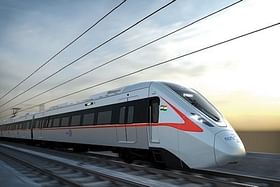A bench of justices S K Kaul and Sudhanshu Dhulia noted that the AAP government has spent Rs 1,100 crore on advertisements in the last three years.
The Delhi government had expressed its inability to contribute funds for the common RRTS project.
Following the Supreme Court’s order, the Delhi government has agreed to disburse Rs 415 crore for the project.
Following the Supreme Court’s order, the Delhi government has consented to disburse Rs 415 crore for the Delhi-Meerut Regional Rapid Transit System (RRTS) within a two-month timeframe.
A bench of justices S K Kaul and Sudhanshu Dhulia noted that the Aam Aadmi Party (AAP) government has spent Rs 1,100 crore on advertisements in the last three years.
The apex court told the Delhi government, “You’ll have to pay your share in the RRTS project. If over Rs 1,000 crore can be spent on advertisements in three years, infrastructure projects can surely be financed. Why are you not releasing funds for RRTS project? You’re spending crores on advertisements.”
“Your one-year advertising budget is more than what you are giving for the project,” reports Times of India.
The Delhi government had expressed its inability to contribute funds for the common project after which the apex court had directed it to place on record funds spent on advertisements in the last three years.
RAPIDX is a Rs 30,000 crore project jointly funded by multilateral institutions (60 per cent), and by central and state governments.
The Centre’s share stands at 20 per cent while the states of Delhi (3.5 per cent), and Uttar Pradesh (16.5 per cent) contribute in proportion to infrastructure being developed in their territory.
Previously, the Supreme Court criticised the Delhi government for claiming its inability to contribute to the construction of the RRTS project.
The court ordered the government to provide details of money spent on advertisements in the last three financial years within a two-week timeframe.
During the hearing, senior advocate Abhishek Singhvi, representing the Delhi government, informed the apex court about the budgetary allocation for advertisements in the previous three years.
Singhvi assured the bench that payment would be made towards the project but requested that the contribution be allowed to be made in installments over a reasonable period of time.
The project involves the construction of semi-high speed rail corridors that will connect Delhi to Meerut in Uttar Pradesh, Alwar in Rajasthan, and Panipat in Haryana.
The National Capital Region Transport Corporation is responsible for the implementation of the project, which is a collaboration between the central government and the respective states.
The corridor will be 82.15 km long and will have 24 stations and will allow commuters to travel from Sarai Kale Khan in Delhi to Modipuram, Meerut in just 60 minutes.
Out of the total corridor length, Delhi will have approximately 13 km with stations at Sarai Kale Khan, New Ashok Nagar and Anand Vihar.


